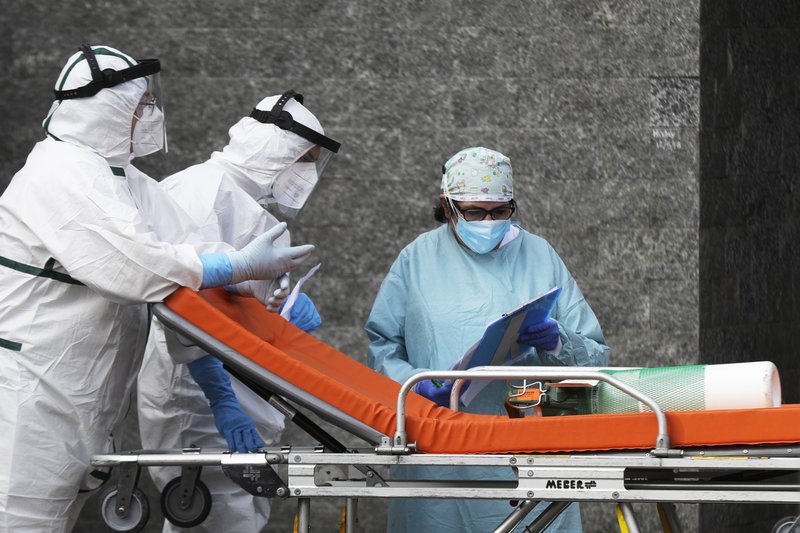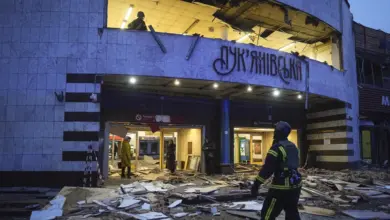
GIUGLIANO IN CAMPANIA, Italy (AP) — Patients, some wrapped in blankets that look like they came from home, moan in their beds. What appears to be medical tubing and a wad of gauze or paper towels litter the floor of San Giuliano public hospital, which treats coronavirus patients in a bleak town in Italy’s Neapolitan hinterland.
In another surreptitiously filmed scene, 15 kilometers (9 miles) away in Naples, an elderly man suspected of having COVID-19 takes his last, labored breaths in a bathroom at the emergency room of Cardarelli Hospital, his undignified end memorialized on a phone camera by a fellow patient and posted online
Meanwhile, outside the ER entrance for Cardarelli, the main health care facility for densely populated Naples, those desperate for oxygen for loved ones line up in their cars, waiting for nurses to bring tanks of the life-saving element to ailing passengers anxious to enter the crowded ER.
The pandemic, which has killed more than 46,000 people in Italy, has heightened the urgency of the plight of those seeking medical care in public hospitals in the country’s economically underdeveloped south. But these glimpsed moments of drama, while shocking, are nothing new to people here who depend on such care.
In late September, as coronavirus infections surged in Italy after a summer decline, prosecutors put 17 hospital managers and workers under investigation for an insect infestation at a Naples hospital. Cardarelli, meanwhile, was once accused by the consumer group Codacons of leaving patients crowded in corridors like they were “old boxes.”
Naples prosecutors are investigating the bathroom death at Cardarelli, and the hospital’s director has ordered an internal probe. At San Giuliano, hospital officials declined to speak to an AP reporter who visited Saturday, and there was no immediate answer at the hospital’s administrative office on Tuesday evening.
Many in the Naples area resign themselves to what the La Repubblica newspaper denounced as hellish, “Dantesque” waits to receive treatment for COVID-19. Others bundle up their loved ones and head north, where Italian health care enjoys a better reputation — but many hospitals there are also overwhelmed.
Lombardy in the north is again the epicenter of Italy’s latest coronavirus outbreak, as it was when the virus first hit Europe. In the regional capital of Milan, coronavirus infections rampaged through the city’s most prestigious home for the elderly early in the pandemic.
In the spring, a severe nationwide lockdown meant that while the north suffered the brunt, the south was largely spared. But now, the virus is hitting several regions hard at once — a phenomenon seen in other European countries.
With the Campania region that surrounds Naples now under strain, at least 116 patients sought treatment this month in neighboring Lazio, at Formia’s Dono Svizzero hospital. Some had tested positive for the virus, while others had other ailments and feared becoming infected with the virus in the area’s chaotic emergency rooms.
“If patients knock on the door, it’s open,” Paolo Nucero, head of the Formia hospital’s emergency room, told Italian state television. “At the moment, we’re holding up. But if we have a super flood, we will start suffering.”
Leaving one’s region to seek better medical treatment elsewhere in Italy is so prevalent that a foundation studying the quality of the nation’s health care publishes what it calls the “flight index.” The GIMBE Foundation found that nearly all those “fleeing” local health care went north.
In Italy’s health care system, each region manages its own spending. In a cruel illustration of the ’’rich get richer while the poor get poorer” adage, footing the medical bills of Italians who travel outside their regions still falls to the region where they reside. That means a bonanza of funds for the northern regions providing the care but a drain on the coffers of poorer, southern parts.
Along the Naples waterfront, Luigi Orefice perched his 4-year-old son, Giovanni, on the thick wall lining the promenade. With fog ringing the Vesuvius volcano in the background, the postcard-like panorama would be familiar to tourists. But his job delivering beverages to hospitals lets Orefice see the ugly realities beyond the “O Sole Mio” image of the south.
His deliveries take him inside hospitals in the dead of night, when Orefice says he has witnessed lax protocols, like staff walking barefoot.
“We might have the best hospital department chief of staffs, but at the bottom, hospital workers are poorly managed,” he said.
Outside San Giuliano Hospital in Giugliano in Campania on a recent day, Feliciano Manna, a representative of the UIL labor syndicate for ambulance crews, noted that Campania lost about 15,000 health care workers in recent years to budget cuts. Italy’s Civil Protection force is currently recruiting 450 doctors to help the region care for COVID-19 patients.
Only weeks before the pandemic began did Campania’s public health care system emerge from years of central government control, part of efforts to cut waste and drive down costs.
The person behind the video inside San Giuliano Hospital “took advantage of a moment when he saw some wad of gauze of the floor,” said Manna. “The staff is doing super-human work,” he said. The video “doesn’t discredit that.”
In a parking lot behind the hospital, Giuseppe Sguiglia, 30, and his 26-year-old wife waited in their car, inching forward in a long line of people signed up for COVID-19 tests.
Last year, Sguiglia said, he had to use a local hospital. Judging from that experience, “we understood that Naples would be a disaster” if the pandemic spread south, he said.
Some cite the insidious influence of organized crime on some of Campania’s institutions.
In response to an AP query, the Interior Ministry said Monday that the minister will decide this month whether a sprawling Naples health care district should be put under temporary control of the ministry’s local prefect — depending on if it’s determined that the Camorra infiltrated its administration.
According to a separate, criminal investigation before the pandemic, mobsters allegedly demanded payment of hundreds of euros to speed up the release of patients’ bodies at one Naples hospital to their families.
___
Follow AP’s coverage at https://apnews.com/hub/coronavirus-pandemic and https://apnews.com/UnderstandingtheOutbreak
Image; An oxygen canister is carried on a stretcher outside the first aid department of the Cardarelli hospital in Naples, Italy, Friday, Nov. 13, 2020. Outside the ER entrance of Cardarelli, the main health care facility for densely populated Naples, those desperate for oxygen for loved ones lined up in their cars, waiting for nurses to bring tanks of the life-saving element. (AP Photo/Gregorio Borgia)




